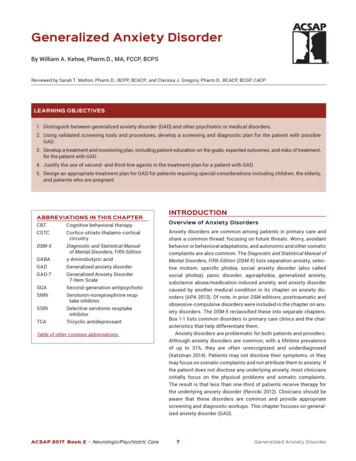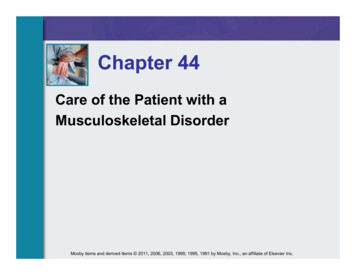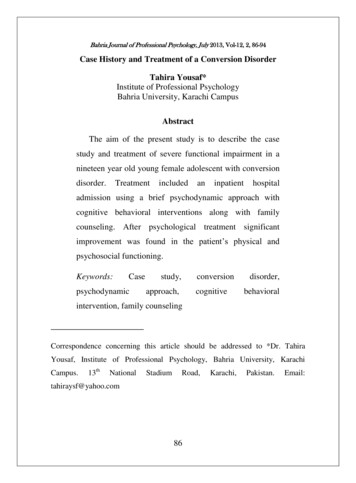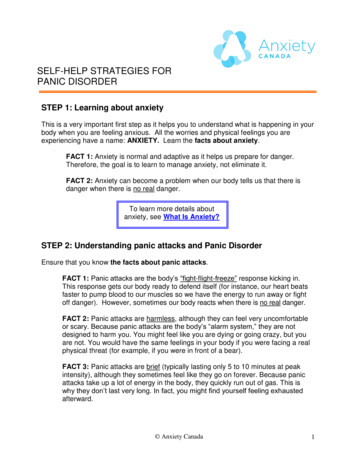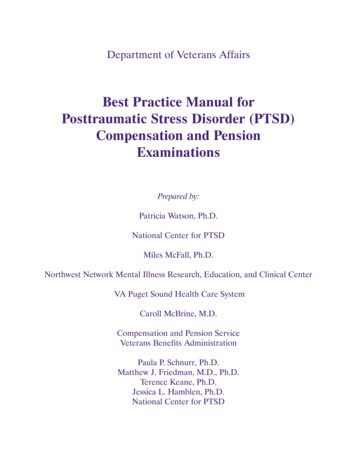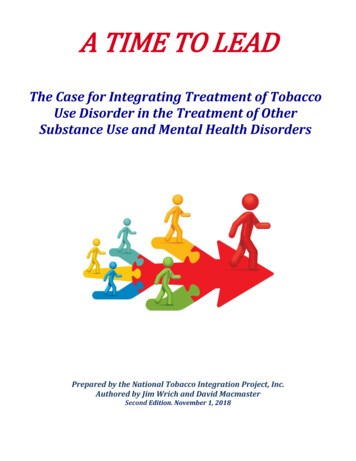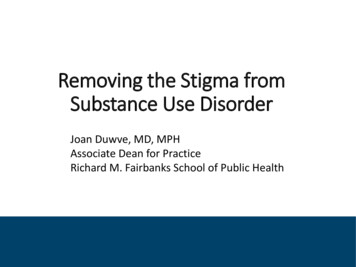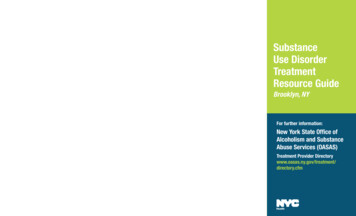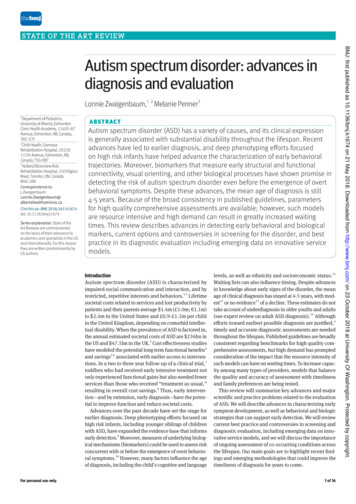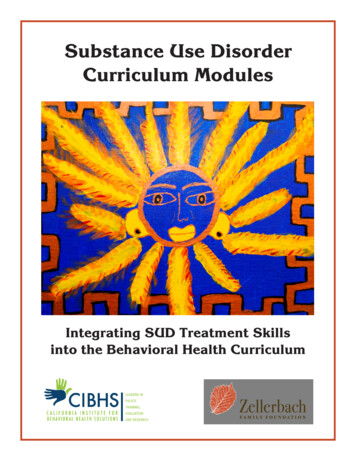
Transcription
Mind 2018Body dysmorphic disorder (BDD)Explains what body dysmorphic disorder (BDD) is, the symptoms and possible causes ofBDD and how you can access treatment and support. Includes tips for helping yourself,and advice for friends and family.If you require this information in Word document format for compatibility with screenreaders, please email: publications@mind.org.ukContentsWhat is body dysmorphic disorder (BDD)?. 2What are the common signs and symptoms of BDD?. 2What causes BDD? . 4What treatments are available for BDD? . 6What can I do to help myself? . 8How can friends and family help?. 9Useful contacts . 101
Mind 2018What is body dysmorphic disorder (BDD)?Body dysmorphic disorder (BDD) is an anxiety disorder related to body image.You might be given a diagnosis of BDD if you: experience obsessive worries about one or more perceived flaws in your physicalappearance, and the flaw cannot be seen by others or appears very slight develop compulsive behaviours and routines, such as excessive use of mirrors orpicking your skin, to deal with the worries you have about the way you look.If you have BDD, these obsessions and behaviours cause emotional distress and have asignificant impact on your ability to carry on with your day-to-day life. In this way, BDD isclosely related to obsessive-compulsive disorder (OCD).BDD can vary in severity from person to person and from day to day. For some of us,concerns around appearance may make it difficult to go out in public or see other people.This can have an impact on our work life and relationships with other people.“It varies day-to-day. It can sit quietly or it can be completely debilitating.”BDD may also cause other problems, such as: feelings of shame, guilt or loneliness isolating yourself to avoid situations that cause you anxiety or discomfort depression or anxiety misuse of alcohol or other drugs feeling you need unnecessary medical procedures, such as cosmetic surgery eating disorders self-harm suicidal thoughts.Many people with BDD do not seek help because they are worried that people will judgethem or think they are vain. This means that many people with BDD are likely toexperience it for a long time before seeking support.What are the common signs andsymptoms of BDD?People with BDD see themselves differently to how others see them. Although everyone'sexperience of BDD is unique, there are some common signs:Common obsessive worries about the bodyIf you have BDD, you experience intrusive, negative thoughts about one specific area ofyour body, or several areas of your body, which you think are:2
Mind 2018 out of proportion too big or too small disfigured lacking symmetry.These thoughts cause you significant anxiety, and you will often spend several hours aday thinking about the area or areas of concern.BDD can affect any area of the body, but common areas of anxiety include your skin,hair, nose, chin, lips or genitals.BDD and eating disordersBDD and eating disorders share similar symptoms, such as: having poor body image worrying excessively about your physical appearance developing compulsive behaviours to try to deal with these worries.However, BDD and eating disorders are not the same. When a person isexperiencing an eating problem, such as anorexia nervosa, they are mainlyconcerned about their weight and shape. Someone experiencing BDD is likely toexperience other concerns around body image – for example, they may also haveconcerns about a particular facial feature.Some people with BDD experience an eating disorder but not all people with eatingdisorders have BDD.A mental health professional, such as a psychiatrist, can assess your symptoms tohelp you find out whether you are experiencing BDD, an eating disorder or both. Formore information, see our pages on eating problems.“I've struggled with BDD for 13 years. It changes. Sometimes it is something little, like mynose, that is really bothering me that day. Sometimes it is every centimetre of my bodythat just feels wrong.”Common compulsive behavioursIf you have BDD, at some point during the course of your obsessions you developcompulsive behaviours and routines to deal with the anxiety you feel about yourappearance.You may spend hours each day carrying out these behaviours to try to reduce youranxiety. The behaviours may briefly lessen your worries, or they may make you feelworse.Common compulsive behaviours include:3
Mind 2018 obsessively checking your appearance in mirrors, or avoiding mirrors completely using heavy make-up to try to hide the area you're concerned about changing your posture or wearing heavy clothes to disguise your shape seeking constant reassurance about your appearance exercising excessively, often targeted at the area you're concerned about frequent body checking with your fingers picking your skin to make it smooth excessive use of tanning products frequent weighing brushing or styling your hair obsessively constantly comparing yourself with models in magazines or people in the street seeking cosmetic surgery or having other types of medical treatment to change thearea of concern.What is muscle dysmorphia?Muscle dysmorphia (or muscle dysmorphic disorder) is a type of BDD where youexperience obsessive worries about your body being too small, skinny or notmuscular enough. Despite these worries, you are of average build or, in some cases,exceptionally muscular.This often leads to compulsive behaviours that focus on building muscle, such as: spending excessive time exercising, specifically lifting weights taking nutritional supplements abusing steroids and other substances.You can find out more about muscle dysmorphia on the Body Dysmorphic DisorderFoundation website.What causes BDD?No one knows exactly what causes BDD. However, recent research suggests that thereare a number of different risk factors that could mean you are more likely to experienceBDD, such as: abuse or bullying low self-esteem fear of being alone or isolated4
Mind 2018 perfectionism or competing with others genetics depression, anxiety or OCD.Abuse and bullyingExperiencing abuse or bullying can cause you to develop a negative self-image and maylead you to have obsessions about your appearance. This is particularly true if youexperience abuse or bullying when you are a teenager, when you may be more sensitiveabout the way you look or how your body is changing.Low self-esteemIf you have low self-esteem, you may become fixated on aspects of your appearance thatyou want to improve. This is more likely if you attach a lot of importance to how you look,or if you feel your appearance is the most valuable thing about you.Fear of being alone or isolatedIf you worry about not fitting into a group of friends or being lonely, you may developthought patterns that can lead to BDD. For example, if you believe that you need to look acertain way to maintain friends or find a partner, you may develop unhelpful concernsabout your appearance. If a relationship then breaks down or a friendship group changes,this could make your concerns worse.“There have been so many times where I have looked in the mirror and just cried. Or I'vethought I looked okay but two seconds later I will feel that it is all still wrong.”Perfectionism or competing with othersIf you try to appear physically 'perfect' or you regularly compare your appearance toother people, you may be more likely to develop BDD. If you have a hobby or job that isvery focused on your body – for example, modelling, bodybuilding or gymnastics – youmay be at greater risk.GeneticsSome evidence suggests that BDD is more common in people whose family members alsohave BDD. But it's difficult to know whether symptoms – such as believing that you aredisfigured or frequent mirror checking – are inherited from your parents' genes or pickedup from their behaviour.Depression, anxiety or OCD5
Mind 2018People with other mental health problems, specifically depression, anxiety and OCD, arealso more likely to have BDD. But it is not clear whether depression, anxiety or OCD area cause of BDD, or if BDD is a cause of these mental health problems.What treatments are available for BDD?If you think you may have BDD, going to your GP is a good place to start. Your GP canprovide an assessment and diagnosis, and help you access appropriate treatment. Ifyou're worried about going to your GP, you might find it helpful to read our pages onseeking help for a mental health problem.If you are diagnosed with BDD, your GP should offer you treatment options according tothe National Institute of Health and Care Excellence (NICE) guidelines. What you areoffered may depend on the severity of your symptoms, but ideally you should be givenCBT before you are prescribed any medication.The NICE guidelines on the treatment of BDD recommend: cognitive behavioural therapy (CBT) – with self-help materials such as books orcomputer programs, via telephone, or via a series of sessions with a therapist in aone-to-one or group setting medication – either on its own or combined with CBT specialist services for BDD, if other treatments do not work.As it is not uncommon for any of us to worry about our appearance, the signs of BDDcan be missed by professionals.If you feel your GP does not recognise your symptoms and you are not getting thetreatment you need, you may find it useful to get an advocate to support you.Cognitive behavioural therapy (CBT)CBT is a form of talking therapy that aims to identify connections between your thoughts,feelings and behaviours. It can also help you to develop practical skills to manage them.CBT can be delivered one-to-one or in a group.For BDD, the aim of CBT is to address the key features of BDD to gradually make youfeel less anxious about your body, focusing on: improving your general attitude to body image and physical appearance your concerns about your perceived physical flaw(s) reducing your need to carry out unhelpful behaviour.CBT is available through the NHS. Your GP should be able to refer you for CBT. InEngland, you may be able to refer yourself via the Improving Access to PsychologicalTherapies (IAPT) programme.6
Mind 2018There is a useful tool on the NHS website which can help you find which psychologicaltherapy services are available in your local area, or you can try searching on the NHS'sgeneral health services search tool (both England only).NHS waiting lists for CBT can be long, so you may decide to see a therapist privately ifyou are able to. Accredited CBT therapists can be found through the British Associationfor Behavioural and Cognitive Psychotherapies (BABCP). See our page for tips on findinga private therapist.Exposure and response prevention in CBTA behavioural element of CBT – known as exposure and response prevention (ERP) –is recommended for BDD. This technique makes you confront your obsessions so youbecome used to dealing with them. This means: facing situations where you would normally think obsessively about the part ofyour appearance that concerns you, to help you cope better with thesesituations over time developing techniques to help you avoid carrying out compulsive behaviours(such as mirror checking) when you would normally want to.This technique needs to be carefully managed to avoid causing additional anxiety anddistress, so it is important that you understand the treatment fully and feelcomfortable with your therapist.MedicationYou may be prescribed antidepressants, either on their own or in combination with CBT,if: CBT is not successful in treating your BDD your BDD is causing you moderate to severe impairment.The type of antidepressant prescribed will usually be a serotonin-specific reuptakeinhibitor (SSRI). This can help to reduce obsessive thoughts and behaviours.SSRIs can cause unpleasant side effects so it is a good idea to discuss this with your GP.You can also take a look at our information on what you should do before you start takingmedication.If a first course of SSRIs and more intensive CBT is not effective, the next step is to try adifferent SSRI or another antidepressant called clomipramine.Specialist servicesIf initial treatment is not helpful, your GP can refer you for specialist help. This could bethrough community-based mental health and social care, where you will be given a more7
Mind 2018thorough assessment by the community mental health team (CMHT). Your CMHT willdevelop a potential care plan with you, which may include support from a service thatspecialises in BDD.Access to specialist services is limited across the country and you may need to traveloutside your local area. Waiting times for specialist services can also be very long.What other treatments are available?Everyone is different and the treatments recommended by the NICE guidelines don'talways work for everyone.You may find different treatments or self-care techniques beneficial, either on their ownor alongside other treatments.The Body Dysmorphic Disorder Foundation provides further information about treatmentsfor BDD on its website.What can I do to help myself?Treatment of BDD often includes a combination of strategies, including self-help. Beloware some ideas you could try to help you manage your BDD:Use self-help materialsMany people find self-help materials, such as books or computer programs, useful inmanaging their BDD. Self-help materials are ofte
very focused on your body – for example, modelling, bodybuilding or gymnastics – you may be at greater risk. Genetics Some evidence suggests that BDD is more common in people whose family members also have BDD. But it's difficult to know whether symptoms – such as believing that you are disfigured or frequent mirror checking – are inherited from your parents' genes or picked up from .

